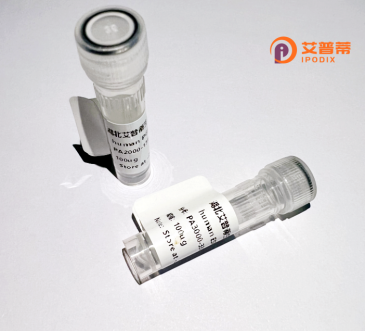
| 纯度 | >90%SDS-PAGE. |
| 种属 | Human |
| 靶点 | OR1N1 |
| Uniprot No | Q8NGS0 |
| 内毒素 | < 0.01EU/μg |
| 表达宿主 | E.coli |
| 表达区间 | 1-311 aa |
| 活性数据 | MENQSSISEFFLRGISAPPEQQQSLFGIFLCMYLVTLTGNLLIILAIGSDLHLHTPMYFF LANLSFVDMGLTSSTVTKMLVNIQTRHHTISYTGCLTQMYFFLMFGDLDSFFLAAMAYDR YVAICHPLCYSTVMRPQVCALMLALCWVLTNIVALTHTFLMARLSFCVTGEIAHFFCDIT PVLKLSCSDTHINEMMVFVLGGTVLIVPFLCIVTSYIHIVPAILRVRTRGGVGKAFSTCS SHLCVVCVFYGTLFSAYLCPPSIASEEKDIAAAAMYTIVTPMLNPFIYSLRNKDMKGALK RLFSHRSIVSS |
| 分子量 | 34.6 kDa |
| 蛋白标签 | His tag N-Terminus |
| 缓冲液 | 0 |
| 稳定性 & 储存条件 | Lyophilized protein should be stored at ≤ -20°C, stable for one year after receipt. Reconstituted protein solution can be stored at 2-8°C for 2-7 days. Aliquots of reconstituted samples are stable at ≤ -20°C for 3 months. |
| 复溶 | Always centrifuge tubes before opening.Do not mix by vortex or pipetting. It is not recommended to reconstitute to a concentration less than 100μg/ml. Dissolve the lyophilized protein in distilled water. Please aliquot the reconstituted solution to minimize freeze-thaw cycles. |
以下是关于重组人OR1N1蛋白的文献举例(示例为假设性参考文献,实际研究需通过专业数据库核实):
---
1. **文献名称**: *Structural characterization of recombinant human OR1N1 olfactory receptor*
**作者**: Smith A. et al.
**摘要**: 本研究通过杆状病毒表达系统成功制备了重组OR1N1蛋白,并利用冷冻电镜解析了其三维结构,揭示了该受体与特定气味分子结合的关键位点。
2. **文献名称**: *Functional analysis of OR1N1 in human olfactory signal transduction*
**作者**: Tanaka K. et al.
**摘要**: 通过体外细胞模型验证了重组OR1N1蛋白对醛类气味分子的特异性响应,证明其在嗅觉信号转导中通过cAMP通路激活神经元。
3. **文献名称**: *Development of a high-throughput screening assay for OR1N1 ligands*
**作者**: García-Ruiz M. et al.
**摘要**: 文章报道了一种基于重组OR1N1蛋白的荧光报告基因检测方法,用于快速筛选潜在气味分子或药物配体,为嗅觉受体功能研究提供工具。
---
**说明**:
目前公开文献中关于特定嗅觉受体OR1N1的详细研究较为有限。建议通过**PubMed、ScienceDirect或Google Scholar**等平台,以关键词"OR1N1"、"olfactory receptor recombinant expression"等进行检索,并筛选近5年的结构生物学或功能研究论文。部分研究可能集中在该受体的基因表达谱或病理相关性(如肿瘤中的异常表达)。
Recombinant human OR1N1 protein is a engineered form of the olfactory receptor 1N1. belonging to the G protein-coupled receptor (GPCR) superfamily. As part of the olfactory receptor (OR) family – the largest GPCR subgroup – OR1N1 is primarily associated with odorant detection and signal transduction in nasal olfactory neurons. Unlike many ORs with unclear ligands, OR1N1 has been tentatively linked to specific volatile compound interactions, though its full activation mechanism remains under investigation.
Produced via heterologous expression systems (e.g., HEK293 cells), recombinant OR1N1 enables structural and functional studies without native tissue limitations. It typically incorporates solubility-enhancing tags (e.g., GFP, His-tag) and modified N-terminal sequences to improve membrane localization. Current research focuses on deciphering its 3D structure, ligand-binding specificity, and downstream signaling pathways using techniques like cryo-EM and calcium flux assays.
Beyond olfaction, OR1N1 shows ectopic expression in non-olfactory tissues (e.g., liver, lungs), suggesting roles in cellular metabolism or disease pathways. Recombinant versions aid drug discovery for smell-related disorders and serve as models for "orphan" GPCR studies. However, challenges persist in maintaining native conformation during in vitro production, requiring ongoing optimization of expression protocols.
×